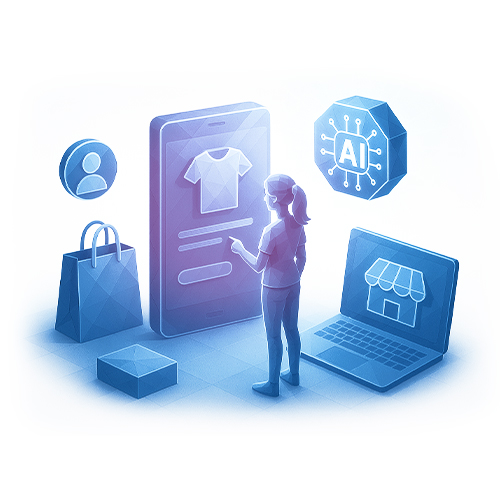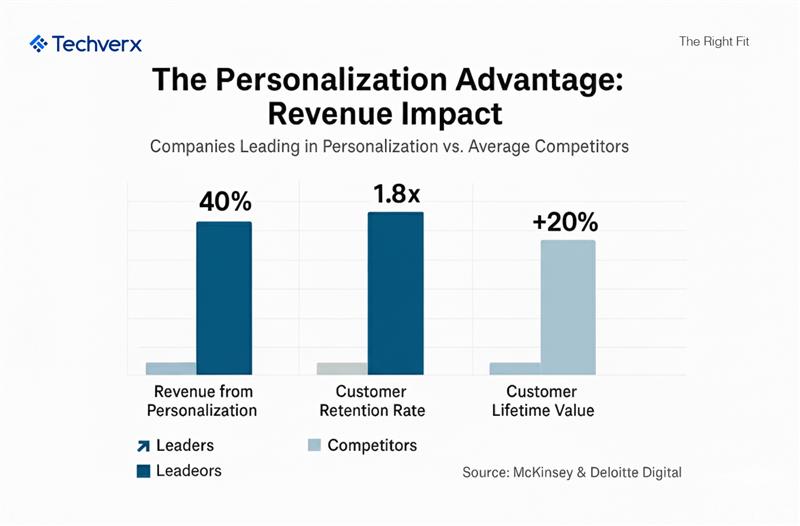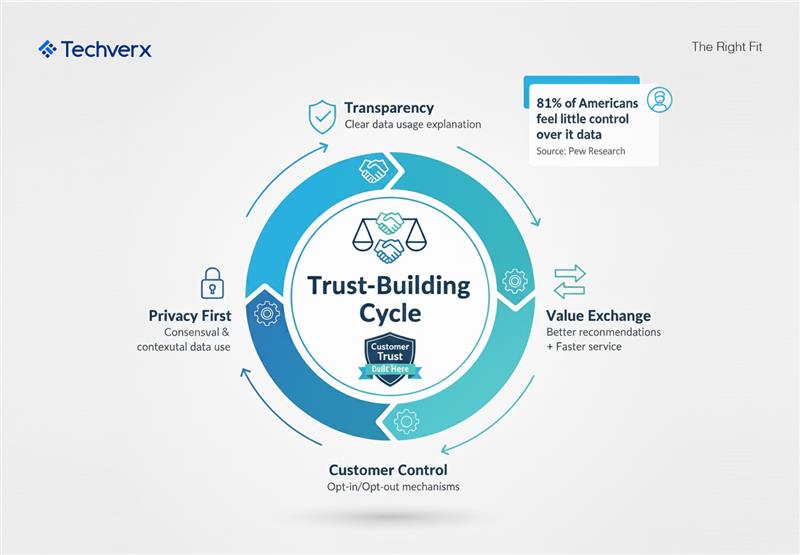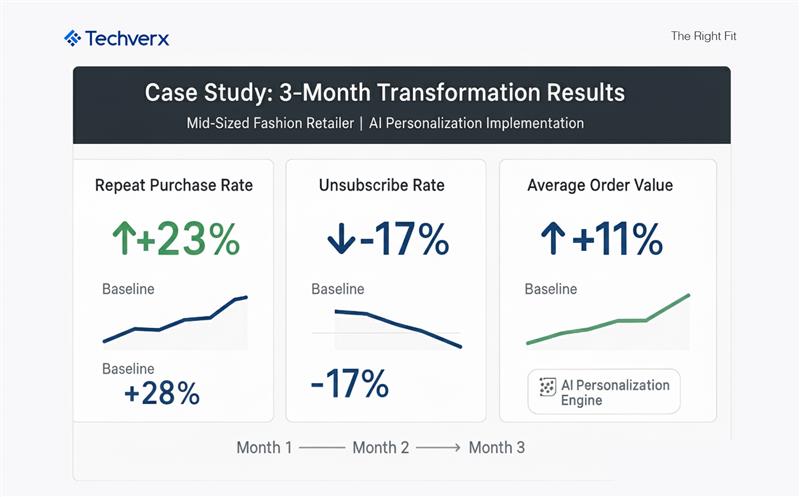
Creating Personalized Shopping Experiences: AI’s Role in Retaining Customers

The Problem With Familiar
It begins the same way for millions of shoppers every day.
A customer lands on an online store, scrolls past the same neon banners promising limited-time deals, clicks through a carousel of “Top Picks for You” that miss the mark, and leaves. They might make a first purchase, but they rarely come back.
This is the quiet crisis behind modern retail, generic shopping experiences that fail to create loyalty. Every website looks familiar, every ad sounds the same, and every promise blurs into noise. Customers don’t stay where they shop, they stay where they feel understood.
And the data confirms it. According to AdAge, more than two-thirds of consumers say they feel overwhelmed and irritated by repetitive, irrelevant ads. Poor targeting doesn’t just waste budgets, it actively drives customers away.
The problem isn’t visibility, it’s connection. And connection, at scale, is exactly what AI personalization was built to solve.
From Transactions to Relationships

Once, winning in e-commerce meant speed and convenience, faster checkouts, lower prices, endless catalogs. But convenience is no longer a differentiator, it’s the bare minimum. The real advantage now lies in understanding the person behind the purchase, not just processing the transaction.
McKinsey’s research shows that companies leading in personalization drive 40% more revenue from those activities than their peers. Customers no longer separate shopping from experience; they expect every click, scroll, and interaction to feel relevant, responsive, and consistent across channels.
That expectation extends everywhere, from the Instagram ad they tap during lunch to the chatbot that answers their late-night question. According to Salesforce, 73% of consumers expect brands to understand their unique needs, while 62% expect personalized offers or discounts based on their history.
Personalization has evolved from a “nice-to-have” into the foundation of modern retail UX. It’s no longer about selling products, it’s about creating relationships that feel intelligent, continuous, and human.
How AI Makes Retail Feel Human Again
For years, automation made retail efficient but impersonal. Now, AI personalization is rewriting that story. It isn’t replacing human insight, it’s scaling it. The real magic lies in recommendation engines that don’t just track clicks but interpret intent.

Modern AI models read signals humans can’t, from micro-interactions and dwell times to search context, local weather, and even subtle shifts in sentiment. They weave those clues into a living map of what a shopper might want next.
For example, a retailer using AI in retail can blend predictive analytics with dynamic recommendation systems to offer products that fit a customer’s actual life. In Seattle, that means raincoats, umbrellas, and waterproof boots. In Miami, it might be travel-size sunscreen and lightweight weekend bags.
It’s personalization that feels effortless, not invasive. And the data backs it up, Deloitte Digital’s Personalizing Growth study found that brands with advanced personalization achieve 1.8 times higher retention and 20% greater lifetime value than their competitors.
Relevance builds loyalty, and loyalty sustains growth.
The Hidden Cost of One-Size-Fits-All
A shopper adds something to their cart, hesitates, and leaves. Multiply that moment a thousand times over, and you begin to see what generic experiences really cost. The loss isn’t just in a missed sale, it’s in the slow erosion of repeat business.

According to Twilio Segment, 56% of consumers are more likely to return after a personalized experience, while 45% will switch brands if it feels generic. Capterra’s research tells the same story at checkout, where nearly 70% of carts are abandoned due to friction, unclear recommendations, missing personalization, or unnecessary steps that break the flow.
Every abandoned cart isn’t just a lost conversion, it’s a lost connection. Poor retail UX doesn’t just cost revenue, it costs trust. In a world where AI personalization can predict intent in real time, “good enough” is the most expensive strategy of all.
Your Shoppers Deserve Better Than “One-Size-Fits-All”
What Personalization Actually Looks Like
AI personalization in retail doesn’t stop at what a shopper buys, it shapes how every interaction feels. The homepage no longer greets everyone the same way, returning visitors see collections that adapt to their browsing history, local weather, and seasonal context. Predictive analytics quietly studies when each person tends to open emails or app notifications and adjusts timing automatically, keeping engagement natural instead of intrusive.
Microsoft 365 Copilot powers chatbots that answer questions, find complementary items, and make thoughtful recommendations in real time, while Dynamics 365 connects those insights to sales and inventory data so pricing adjusts organically for different audiences. Even after checkout, feedback loops analyze returns and reviews to refine what each shopper sees the next time they visit.
Each of these moments forms a quiet dialogue between brand and customer, a sense that the store recognizes them, remembers them, and meets them halfway. That is what a truly intelligent retail UX feels like, not automation, but attention.
Why Trust Matters More Than Data
As personalization deepens, so does the customer’s sensitivity to privacy and transparency. Pew Research reports that 81% of Americans feel they have little or no control over the data companies collect, and that discomfort shapes how they interact with brands.

This is why modern AI in retail must go beyond basic compliance. Personalization should be consensual, contextual, and clearly explained. When shoppers understand how their data improves their experience, they become collaborators, not skeptics. Faster service, smarter recommendations, and relevant offers feel less invasive when the value exchange is visible.
The best retailers now treat data like a shared currency, not a secret asset. They tell customers what’s used, why it’s used, and what they gain in return. That transparency turns algorithms into trust engines, and trust is what keeps customers coming back long after the first purchase.
When Personalization Meets Purpose
Personalization shouldn’t just sell more, it should make people feel understood. A brand that remembers preferences or anticipates needs builds the same emotional bond that local shopkeepers once managed by memory. The tools have evolved, but psychology hasn’t.
AI in retail now bridges that old familiarity with modern precision. Through retail UX design, data analytics, and adaptive recommendation engines, brands can make every click feel considered, every ad feel timely, and every purchase feel intentional. This human layer transforms convenience into connection, turning ordinary transactions into experiences that stick.
Case Study: From Frustration to Familiarity
A mid-sized fashion retailer was losing repeat customers. Their emails were opened, but conversions lagged. The issue wasn’t the offer, it was relevance. After implementing an AI personalization engine integrated with Dynamics 365, they began segmenting shoppers dynamically in real time.
Instead of blasting one newsletter to everyone, the system created thousands of individualized versions based on browsing and purchase patterns. Within three months, repeat purchase rates jumped 23%, unsubscribes dropped 17%, and average order value rose 11%.
The shift wasn’t about price or promotion, it was about recognition. Shoppers no longer felt targeted, they felt understood, and that made all the difference.

The Future of AI Personalization
Graham Cook, one of the pioneers of e-commerce personalization, calls this the third act of commerce, where AI transforms raw data into living intelligence. Recommendation engines are merging with generative AI, creating content on the fly, from personalized product copy to conversational messages that sound human.
Microsoft Copilot is already enabling this for enterprise retailers, analyzing journeys and crafting responses that reflect real intent. Soon, digital twins of customers will let systems simulate buying behavior before it happens, helping brands anticipate needs without crossing privacy lines.
McKinsey projects that companies mastering this level of personalization could boost marketing ROI by up to 30%. But even as AI grows smarter, the rule stays simple: technology can predict patterns, but only empathy can earn trust.
Why Retention Is the Real ROI
Customer acquisition costs keep climbing, but retention builds real profitability. Salesforce reports that 84% of consumers are more likely to stay loyal to brands that treat them as individuals, not numbers. Loyalty doesn’t come from flashy ads, it comes from the small, consistent moments that feel thoughtful.
It’s the chatbot that remembers your last order. The email that reflects what you browsed. The app that recalls your size before checkout. Each of these interactions either strengthens trust or chips away at it.
AI personalization ensures those moments work together, turning scattered touchpoints into a single, coherent experience. In the end, customers don’t stay because of discounts or convenience, they stay because the brand feels alive, like it’s paying attention.
Techverx: Powering the Future of Personalized Retail
At Techverx, we help retailers evolve from static systems to intelligent experiences. Our engineers specialize in Dynamics 365, Azure, and enterprise AI integration, building connected ecosystems where personalization, data, and UX flow as one.
From recommendation engines to Copilot-driven assistance, we design architectures that anticipate rather than react. Whether you’re optimizing retail UX, enhancing loyalty programs, or aligning personalization with privacy standards, Techverx brings the technology and strategy to make AI in retail actually feel human.
Let’s build the kind of experience that customers remember, and return to.

Amanda Hill
Amanda Hill is a Technology Implementation Specialist at Techverx, where she combines her expertise in data analysis, digital transformation, and project management to bring complex ideas to life. Passionate about innovation and operational efficiency, she helps clients seamlessly execute technology solutions that drive measurable impact.
Hiring engineers?
Reduce hiring costs by up to 70% and shorten your recruitment cycle from 40–50 days with Techverx’s team augmentation services.
Related blogs


